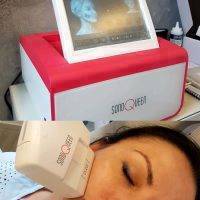HIFU Facelift Side Effects
Side effects from HIFU facelift may manifest as reddening of the skin during the procedure. Subsequently, this reddening will disappear within a few hours.
You can also feel a tingling sensation during treatment. Sometimes there may be slight swelling, slight bruising, numbness, but all these side effects are fleeting.
HIFU facelift is not dangerous if it is weak, and also subject to the norms of its use, prescribed in scientific articles and manuals.
Light skin swelling, increased muscle tone and slight discomfort are rare, but due to the individual skin features it is possible. You do not need to worry about this, within 3 days they will disappear.
Contraindications
The most common contraindications are:

Before And After HIFU For Men
- Impaired motor functions, namely paralysis of facial muscles;
- Presence in the area of exposure of metallic materials or gold implanted in bone and tissue;
- Local infectious pathologies;
- Skin diseases at the stage of development (eczema).
HIFU facelift is the only non-invasive technology that affects the deep layers of the skin, the effect of which has been proven many times.
But the technique has its own characteristics and contraindications.
What is it?
Skin lift is carried out due to the influence on it of HIFU of high frequencies, which heat tissues, massage them and saturate with oxygen, smoothing wrinkles and tightening the contour of the face. Due to the effects of , the skin cells are more quickly renewed, the keratinized areas peel off and sebaceous plugs break. The second name of HIFU facelift is SMAS facelift, which says that the Uz-waves penetrate into the subcutaneous muscle-aponeurotic layer and act on it. This layer is responsible for a clear contour of the face, it consists of elastin and collagen fibers, which eventually lose their properties.
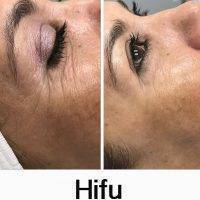
HIFU Face Tightening Before And After
The SMAS facelift is effective because high intensity focused ultrasound penetrate the skin to a depth of up to 5 mm and there they affect the tissues, other non-surgical methods allow the skin to work up to only 1.5 mm, so the effect is short-lived and shallow.
Indications for the procedure.
Any medical intervention in the body should be justified, therefore it is recommended to do HIFU facelift only to those people, who have indications for the procedure. With it, you can correct age-related changes without exposing yourself to surgery, or prolong the effect of a surgical face lift that was conducted several years ago.
Indications:
- Age over 40 years;
- Flabbiness of the skin of the face;
- Deep wrinkles;
- Distortion of the face;
- Second chin and excess skin;
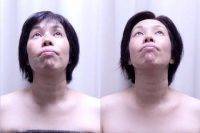
HIFU Facelift Treatment Before And After
- Age-related ptosis;
- Asymmetry of the face;
- ptosis of eyebrows;
- thinning the upper lip;
- Overhanging the skin of the eyelids;
- Crow’s feet;
- Strongly pronounced nasolabial folds.
Contraindications
Despite the absence of surgical intervention during the procedure, HIFU facelift still has a number of contraindications:
- Period of pregnancy and breastfeeding;
- Children’s age;
- Epilepsy and other chronic neurological diseases;
- Injured skin in the affected area;
- Presence of irritation, acne, purulent and herpes rashes;
- Infectious diseases during the procedure;
- Malignant and benign tumors;
- diabetes;
- Metal implants in the affected area;
- The presence of an electrical device in the body;
- Presence of a pacemaker.
Advantages and disadvantages
The main advantage of the non-surgical technique is the absence of risks associated with surgical intervention. The tissues are not damaged, therefore the possibility of infectious diseases is completely disappearing. After the procedure, there is no scars on the skin and there is no need to go through a long recovey.
Due to the non-surgical facelift, you can:

HIFU Is A Revolution In Non-surgical Facial Rejuvenation
- lift the corners of the lips and eyes;
- Smooth out the neck;
- Smooth out fine and deep wrinkles;
- Tighten the skin on the cheeks;
- Correct the outline of the face.
Advantages of the methodology:
- Long-term effect of the procedure which is from one year to four years;
- The possibility of affecting all areas of the face;
- Absence of painful sensations and recovery period;
- Can be combined with other rejuvenation procedures;
- Deep impact, stimulation of the collagen layer;
- Safety for the body.
- Disadvantages of the technique is practically non-existent, while observing the contraindications of side effects in patients was not observed.
In rare cases, there are such consequences as:
- Feeling of numbness in the lips and eyelids;
- Absence of effect in 10% of cases;
- The appearance of seals;
- Pain with pressure;
- redness.
All the unpleasant sensations associated with HIFU facelift, take place within 2-3 hours and do not cause severe inconvenience to the patient. Do not make the procedure before the age of 40, even if the cosmetologist insists. Patients of a younger age can achieve the desired effect with an alginate mask and massage. And the effect of HIFU facelift may not be, because the signs of aging are still very little, and the collagen in the skin is still sufficient.
Risks and complications
Risks during the procedure are minimal, since the skin is not damaged. The only complication that can occur is a burn of the face.
Avoid it, you can listen to your feelings, because the procedure should be virtually painless. If the patient feels severe pain or burning, then it is necessary to reduce the intensity of exposure, it is impossible to tolerate.
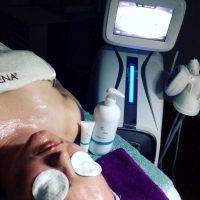
HIFU Ultrasound Facelift
How is HIFU facelift performed?
A facelift is performed using a special HIFU device that emits ultrasound at high frequencies and acts pointwise on the required area, slightly injuring soft tissues. When such microtraumas become many, the SMAS begins to twist and drag the upper layers of the skin behind them, pulling them up. Lifting occurs symmetrically, the face becomes even and taut.
Preparation for the procedure
Before the procedure, the patient is always examined by a dermatocosmetologist. He assesses the patient’s situation, checks for contraindications and indications for a non-surgical facelift.
For three days before the procedure, cosmetic products with glycolic and salicylic acid or isotretion can not be used. Also, smoking, drinking of alcohol and drugs are not recommended.
How is the procedure performed step by step?
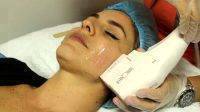
Hifu Facelift Machine
- The procedure begins with removing the make-up and using a special lotion, which is selected for the type of skin. In some clinics, an anesthetic cream is applied to the face of the patient to make the procedure more comfortable.
- The next step on the skin is marking, which will be followed by the procedure.
- At the 3rd stage, the cosmetologist applies a special gel to the skin and selects the nozzle, depending on what effect is to be achieved.
- At the last stage, the skin is directly affected by ultrasound. The doctor applies the radiator to the necessary area and leads them in parallel, at this time the radiation actively warms up the internal tissues and tightens the skin.
- The procedure lasts an average of 40 minutes to an hour, but in some cases the procedure can last up to 2 hours. The time of exposure depends on the area that must be worked on and the skin condition of the patient.
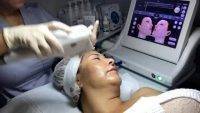
High-Intensity Focused Ultrasound
Recovery
No special measures are taken after the procedure. Leaving the cosmetologist’s office, the patient can immediately drive a car or go to work. The first few hours may have a slight reddening on the skin and numbness, which quickly and without a trace passes.
Results of the procedure
The first effect of the procedure is immediately noticeable: the face becomes more taut and the wrinkles less noticeable. The face will not only look younger, but will also become fresh and will take beautiful forms.
After a few months, the effect of manipulation will only increase, due to the fact that high intensity focused ultrasound, penetrating the skin, act on the collagen layers. Within 3 months, collagen begins to actively renew, tightening the skin and rejuvenating the face.

Male HIFU Face Lift Before And After
By the end of 5 months after the procedure, the effect will manifest completely and will be fixed for a long period of time from one year to four years.
The procedure of HIFU facelift can cause problems in those who are prone to excessive overgrowth of connective tissue and scarring.
On the surface of the skin, small punctate scars are not visible, but can seriously complicate the plastic surgery because of dense splices. It is necessary to inform the doctor in time that a slight tingling develops into intense pain in order to reduce the risk of complication.
You do not need to endure this pain, since less intense radiation will give you the same lifting effect, but without strong internal burns, which can lead to the development of punctate scars.
The most common side effects of the HIFU facelift:
- Slight redness, usually occurs within a couple of hours after the procedure;
- Weak edema, can last 2-3 days;
- Soreness of the skin with pressure or constant discomfort disappears after 2-4 weeks;
- Temporary loss of sensitivity of some skin areas, can last 5-7 days.
